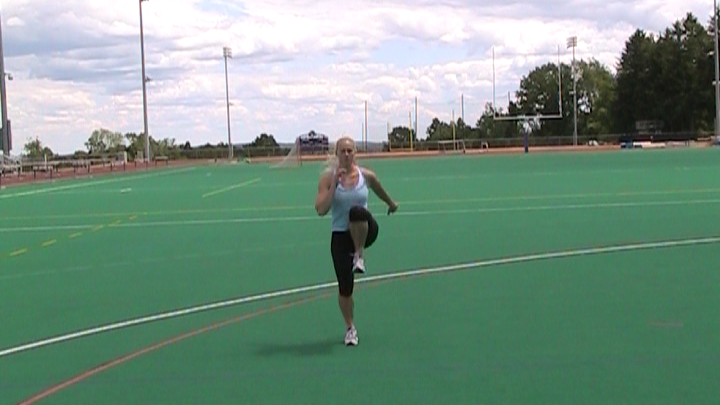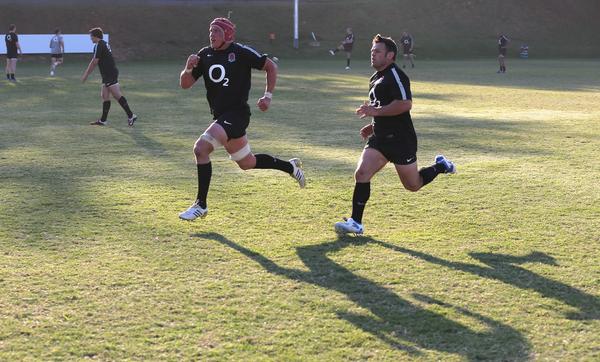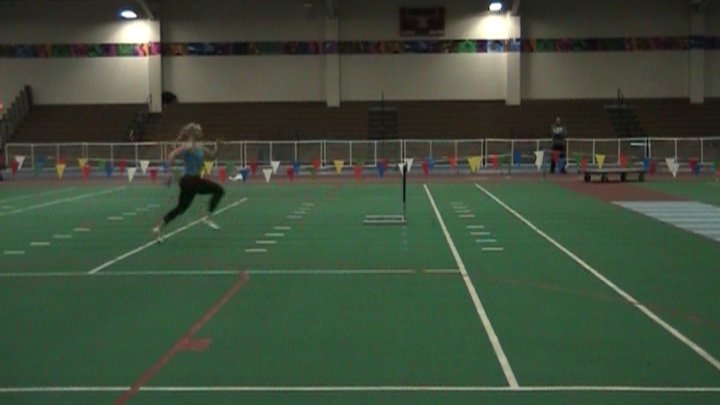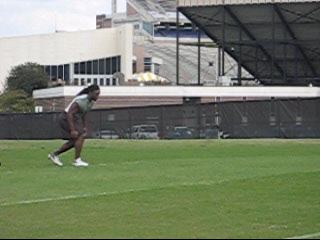Coaching and programs are environmental. Different group numbers, different facilities, differing athlete levels, differing amounts of time to train, and different training and sport loads demand different solutions. In Acceleration Imbalance Part 1 I examined some of the problems field and court sport athletes encounter with acceleration dominant programs. In this article, I’ll share some of the complementary sprint and run programming options I’ve found to result in more balanced and superior results. Which options fit best depend on your athletes, your program, and your environment.
Acceleration Antidotes
Locomotion in the Warm Up- This seems incredibly simple, but with the large mobility deficits in many of today’s athletes (and the current awareness of foam rolling and corrective exercise (often warranted) many programs don’t take enough time to move athletes. Doing dynamic flexibility has value, but it’s not the dynamics nor does it demand the tissue and joint dynamics of locomotion. Skipping variations and running should constitute a good portion of the warm up if you want athletes to run free and well. Getting moving, getting upright, and getting some hip extension and thigh separation is a good warm up and good training. In sports where athletes always work short or don’t move much, finding spots in the training and competition week where athletes can get in quality warm ups is often cleansing.
Run in the Warm Up- With able athletes, I’ve grown to using more running in the actual warm up as athletes don’t become skilled at running without doing it. One way I like to do this is placing strides in between blocks of skips or drills to build additional warmth while also working on general running skill. These are usually very low key strides at around 70% speed. They are fast enough to have decent mechanics and posture, but are still easy strides. They serve as low intensity upright work as well as providing an opportunity to coach upright running in a simple scenario. Further these runs are at extensive tempo speeds and serve as an opportunity to rehearse and coach mechanics for that type of work. (In the private sector much of the athlete’s training is homework, so having some coaching time on elements not often seen is valuable).
An additional warm up setup I’ve used to interject more running is continuous in nature. It includes strides that have dynamic flexibility work and drills in the walk back or rest period. Over the course of this warm up the speed of the strides or buildups ascends.
Build me up– Buildups are a classical running exercise to hone technique and relaxation while warming up for speed. Speeds can be capped to appropriate and safe levels and buildups can be more gradual in nature or more aggressive. The athlete is exposed to upright posture and speed work at the level of your choosing. If space allows, you can also extend the distances of these out or build and maintain to broaden the exposure to upright mechanics.
Quality Tempo and Submaximal Running- In many field sports like football and soccer, classical extensive tempo is a viable conditioning option to support sport performance. If well executed, it’s also upright submaximal running (lazy postures and jogging speeds don’t cut it). Quality tempo also tends to make hearty athletes with more durable tissue.
I’ve also found tempo speeds to be therapeutic for some athletes. One extreme example is World Cup bobsleigh brakemen who accelerate for a living. When on the circuit they are accelerating and pushing 4 days a week with no sport variety while also traveling every weekend. Space is often limited, but when possible and appropriate, I’ve had success freeing up these athletes by doing a series of submaximal runs. These are done on non-high intensity days at fast extensive tempo to lower end intensive tempo speeds. Rest periods are prescribed so conditioning isn’t harsh and the runs serve as a tonic to relieve anterior chain tissue tension.
Intensive Tempo For Non Lactic Sports?– In working with off season football players (skill positions) I’ll sometimes use intensive tempo like workout setups for part of their sprint work. Football is an aerobic-alactic sport so many would see this as non-compatible training. However, not everyone can handle 3 or 4 pure sprint training days a week. In the off season many guys are a ways a way from being able to handle full-bore upright sprint work. This fast, but not maximal upright work, helps serve as a bridge to more pure speed. The posture and speeds also serve as an elixir to open athletes up from all the acceleration based training.
Additionally, special team’s athletes and receivers find benefit from the rhythm developed in longer running. Similarly, this work is also applicable for sports like lacrosse where athletes make end to end changes. An example weekly high intensity setup I’ve used with success includes 2 acceleration based days and one day of 8×80 intensive tempo.
Some Speed Options To Stay Free
Accelerations and A Bit About Distances- In field and court sports it’s a given that you’ll be doing acceleration based sprint work. How far out you take your accelerations depends on where you are in training and your individual sport and athlete needs. A 20 yard accel for a high level wide receiver is flirting with speed, but is not exposing them to the really fast upright stuff. However, a 20 for a heavy basketball center or an offensive lineman is likely nearing top end. Conversely, we’d need to do an acceleration out to 30 or 40 to start challenging our receiver’s top speed.
Even with athletes that don’t necessarily get to top end in their sports, I’ve still found advantages in progressing acceleration distances out to points near or at max V. The limb speeds, frequency, hip extension values, posterior chain development, relaxation, and elasticity developed by upright and top end speed work is unique and something most athletes should not neglect.
Starting High and Rolling- I’m not talking elicit activities, but doing speed work from rolling initiations and higher starting positions. It’s popular to put athletes in pushup starts and deep angles. However, the reality is much of their sport sprints begin with high two point starts or they are already on the move.
Two point starts are unique in that they are more hip and frequency dominant, bringing athletes upright sooner. With football LBs and WRs, simply starting some of their off-season speed work in 2 point and positional stances prepares them for these demands. In tightly spaced training facilities (20-30 yards to run), these higher static starts allow you to put athletes in more upright scenarios despite space limitations.
Rolling sprints are an upright start variation where the athlete sprints from a jog in or shuffle. These runs are very similar to how most sport sprints begin. The frequency demands are high and the athlete is quickly into top speed mechanics (Rolling Fast Easy Fast video below has this kind of start).
Accel and Maintain- This is simply a sprint with a prescribed acceleration zone and then a maintenance zone where the athlete continues sprinting upright, maintaining the speed they built in the accel. Charlie Francis’ GPP Essentials helped popularize this concept for a lot of folks including myself. An example would be 20+10 (sprint 20m, maintain 10m). The maintenance zone can be lengthened to broaden the exposure to upright work.
As a coach, I get the acceleration training and upright sprinting at a velocity I’m comfortable with and the athlete is prepared for. These are a great way to integrate upright work to stay free while also learning relaxation and sprinting skill. This work also serves as a bridge between increasing acceleration distances and the accompanying increases in speed (some 20+10s preceeding a training cycle where I’m going to be accelerating out to 30). This allows the coach to preview mechanics and expose the athlete to forces to come.
Back to Buildups- As mentioned above buildups are an excellent running modality to warm up for speed. More aggressive buildups past 90% speed are obviously getting into true speed work. Buildup variations combining a plyo into a build/sprint or a run with a unique posture focus can also fit here.
One such example I’ve used is an A run buildup (I learned from Carl Valle via Charlie Francis). The athlete starts with an A run (high knee run) and gradually adds forward speed while maintaining posture until they are sprinting. The A run should start (make sure they can do a good A run first) the athlete in good upright pelvic position and the challenge to the athlete is to maintain the frequency and posture through the run. This serves as an excellent tool for teaching what the posture of maximal speed feels like while also exposing the athlete to a taste of upright speed work.
Variable Speed Runs- Sprint-float-sprint or Fast-Easy-Fast are zoned runs in which the athlete accelerates, relaxes/floats, and then accelerates again. In track and field this type of run is often used to teach distribution of effort in short speed endurance scenarios. For field and court sport athletes I’ve found occasional utility in these runs to help athletes break through upright speed barriers and also prepare them for longer runs inherent to their sports. I’ve coached some American football special teamers who really liked this type of work and found it a big help for kickoff returners and kickoff coverage preparation. In kick coverage guys are sprinting to build speed, floating while figuring out where to go or who to hit, then attacking and sprinting to the play or their assignment. In this type of work the athlete is also getting a broad exposure and preparation for upright running.
Flys And Absolute Speed- Flys are basically pure maximal velocity work (30 yard build to 15 yard fly for example) and require solid preparation. I’ve had some athletes who do great just running a 50 yard sprint for this type of work. I’ve coached others who did much better distributing the acceleration a bit and really letting loose in a fly. If the goal here is indeed maximal speed development it’s worth recording with good video equipment or laser timing to see which method is producing the higher upright velocities. Absolute speed work has the highest frequency, hip extension values, and shortest ground contact times of any sprint work. As mentioned in part 1 the pelvis is in a comparatively more posterior tilt orientation in top speed and the demands on the posterior chain are extremely high. The posture and forces found here are second to none for opening up prepared athletes for speed.
Putting it All Together
For a given field and court sport athlete you are not going to be using all of the above options simultaneously. Just as mentioned in the opening, it’s about choosing the correct options to make programs more complete and a better fit for the athlete and the realities of their training environment. Simply put, in field and court sports, I’ve found better results by complimenting the acceleration dominant nature of the sport with appropriate and balancing run training elements.
FOLLOW US FOR MORE -
SHARING IS CARING -








Speak Your Mind